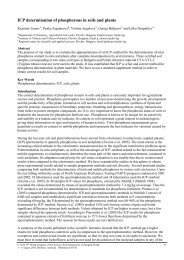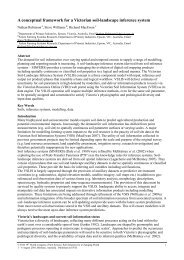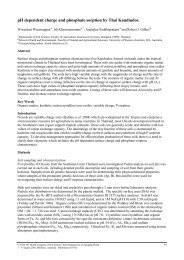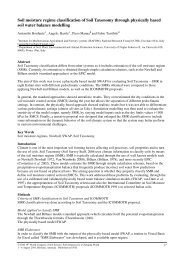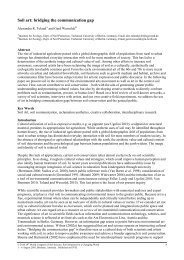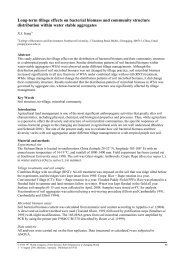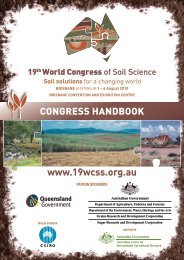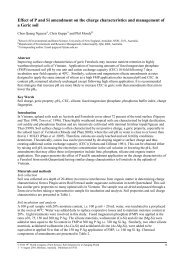Hoang Thi Thai Hoa
Hoang Thi Thai Hoa
Hoang Thi Thai Hoa
Create successful ePaper yourself
Turn your PDF publications into a flip-book with our unique Google optimized e-Paper software.
Sandy soils in South Central Coastal Vietnam: Their origin, constraints and<br />
management<br />
<strong><strong>Hoa</strong>ng</strong> <strong>Thi</strong> <strong>Thai</strong> <strong>Hoa</strong> A , Phan <strong>Thi</strong> Cong B , <strong><strong>Hoa</strong>ng</strong> Minh Tam C , Wen Chen D, E and Richard Bell D<br />
A Hue University of Agriculture and Forestry (HUAF), Hue city, Vietnam Email hoanghoa1973@yahoo.com<br />
B Institute of Agriculture Science of South Vietnam (IAS), Hochiminh city, Vietnam<br />
C Agricultural Science Institute for Southern Central Coast of Vietnam (ASISOV), Quy Nhon city, Binh Dinh province, Vietnam<br />
D School of Environmental Science, Murdoch University, Western Australia<br />
E Department of Agriculture and Food, Western Australia<br />
Abstract<br />
In Vietnam, sandy soils are distributed mainly in the coastal central provinces where they occupy 337,768 ha<br />
comprising 63 % of the nation’s sandy soils, and they are also important to regional economic growth where<br />
more than 10 million people are living i.e.14 % of the Vietnamese population. The sandy materials in the<br />
central coastal Vietnam originate from mostly in situ weathering of granite although aeolian sediments are<br />
parent materials for sandy soils also. Sandy soils have a wide range of limiting factors for agricultural<br />
production, including nutrient deficiencies, acidity, low water holding capacity and wind erosion risk (on<br />
coastal dunal sands). Although there are soil fertility constraints to the use of sandy soils in Vietnam, 79,076<br />
ha has been utilized in agriculture. Developing integrated nutrient management practices are needed to<br />
improve soil physical, chemical and biological fertilities of sandy soils. For example, systematic use of<br />
farmyard manures, crop residues, green manures, and alley cropping need to be considered. Developing<br />
integrated nutrient management practices also need to address environmental considerations by matching<br />
nutrient applications to crop needs and amending soils to minimise nutrient losses to water. Developing new<br />
soil management technologies (such as use of biochar, slow release fertilisers and minimum tillage) is also<br />
important for sustainable management of sandy soils in Vietnam.<br />
Key Words<br />
Nutrient deficiencies, soil acidity, soil fertility, integrated nutrient management<br />
Introduction<br />
Sandy soils occur in many parts of the tropics but low fertility and low water retention are major constraints<br />
to their agricultural productivity. Most of these soils are strongly acidic and have low organic matter content.<br />
In addition, as the clay fraction is also low in these soils, the cation exchange capacity (CEC) mostly depends<br />
on organic matter which also serves as the major component of the adsorbing complex for water (Le Thanh<br />
Bon, 1996; Le Sam and Nguyen Dinh Vuong, 2008; <strong><strong>Hoa</strong>ng</strong> <strong>Thi</strong> <strong>Thai</strong> <strong>Hoa</strong>, 2008).<br />
In Vietnam, sandy soils are distributed mainly in the coastal central provinces where they occupy 339,339 ha<br />
comprising 63 % of the nation’s sandy soils (Table 1 and Figure 1). While the sandy soils occupy only 1.6 %<br />
of the territory and 4.6 % of agricultural land, they are important to regional economic growth where more<br />
than 10 million people are living i.e. 14 % of the Vietnamese population (Pham Quang Ha et al., 2005; Tran<br />
Van Y et al., 2006).<br />
The purpose of this review paper is to review the current knowledge to identify the main constraints for the<br />
development of productive and sustainable farming systems on sandy soils in central coastal Vietnam and<br />
help developing integrated nutrient management practices.<br />
Table 1. Area of coastal sandy soils in Vietnam.<br />
Local name All Vietnam (ha) Coast central areas (ha)<br />
Yellow & white sandy dune soil 222,043 134,113<br />
Red sandy dune soil 76,886 75,000<br />
Sandy marine soil 234,505 130,277<br />
Total 533,434 339,339<br />
Source: Vietnam Soil Association, 1996<br />
Origin and classification of sandy soils<br />
The sandy materials in central coastal Vietnam originate from mostly granitic geologies. Sandy soils formed from<br />
in situ weathering of granite occur in the coastal zone of south central Vietnam. However, the sandy sediments<br />
also form the soil parent materials after transport by fluvial, marine and aeolian processes (NIFS, 2001).<br />
© 2010 19 th World Congress of Soil Science, Soil Solutions for a Changing World<br />
1 – 6 August 2010, Brisbane, Australia. Published on DVD.<br />
251
Figure 1. Soil map in Vietnam (NIFS, 2001).<br />
Sandy soils as defined in the World Reference Base (FAO-ISRAC-ISSS, 1998) as containing 65 % sand in the first metre of the solum, however, this still represents a broad range of soils with clay<br />
contents from 1-17 % and a wide range of chemical and mineralogical properties. The Vietnamese definition<br />
of sandy soils comprises all soils with sand content >80 % and encompasses degraded soils distinguishable<br />
by a relatively low clay and organic carbon content (Nguyen Van Toan, 2004). According to the Vietnam<br />
soil association (1996), the sandy soils may be classified mainly into 3 units: white and yellow sand dune<br />
soils; red sand dune soils and sandy marine soils representing 41, 15 and 43 %, respectively of the total<br />
(NIFS, 2001).<br />
Constraints<br />
Sandy soils have a wide range of limiting factors for agricultural production, which include nutrient<br />
deficiencies, acidity, low water holding capacity and on the dunal sands, susceptibility to wind erosion<br />
(<strong><strong>Hoa</strong>ng</strong> <strong>Thi</strong> <strong>Thai</strong> <strong>Hoa</strong>, 2008). The soil physical and chemical properties of sandy soils are summarized in<br />
Table 2. Generally, sandy soils are strongly acidic with the mean pH KCl below 4.7 but in particular cases of<br />
sandy marine soils that contain carbonate fragments, pH KCl of Vietnam sandy soil may exceed 6.0. The<br />
coarse texture of sandy soils together with low organic matter often leads to a low water holding capacity<br />
and high infiltration rate which represent major challenges for agriculture production (<strong><strong>Hoa</strong>ng</strong> <strong>Thi</strong> <strong>Thai</strong> <strong>Hoa</strong>,<br />
2008). Three hundred cultivated sandy soils from Thua <strong>Thi</strong>en Hue province showed a very large variation of<br />
organic content. The average was 1.08 % (standard deviation of 0.67) (<strong><strong>Hoa</strong>ng</strong> <strong>Thi</strong> <strong>Thai</strong> <strong>Hoa</strong>, 2008). Both<br />
acidity and organic content of sandy soil may be influenced by agronomic activity, water logging condition,<br />
rate of organic material mineralization and sea water contamination (Nguyen Cong Vinh, 2005).<br />
Deficiencies of essential nutrients for crop production on sandy soils are often reported. For example, an<br />
omission experiment conducted in Binh Thuan province (Nguyen Cong Vinh, 2005) revealed that<br />
deficiencies of essential nutrients for crop growth were N>P>K and B>Mo>Zn for red sandy soils and<br />
P>N>K and B>Mo>Zn for white sand soils.<br />
© 2010 19 th World Congress of Soil Science, Soil Solutions for a Changing World<br />
1 – 6 August 2010, Brisbane, Australia. Published on DVD.<br />
252
Table 2. Soil physical and chemical properties of sandy soils in Vietnam.<br />
Indicators<br />
Red sand dune soil<br />
(1)<br />
Sandy marine soil<br />
(2)<br />
White and yellow sand<br />
dune soil (3)<br />
Bulk density (g/cm 3 ) 1.48 1.51 1.31<br />
Particle density (g/cm 3 ) 2.63 2.65 2.62<br />
Porosity (%) 44.0 43.0 50.0<br />
Clay (%) 1.7 11.6 0<br />
Silt (%) 1.7 11.6 0<br />
Sand (%) 96.6 76.8 100<br />
pH KCl 4.20 6.30 5.40<br />
OC (%) 1.43 0.52 0.08<br />
N (%) 0.080 0.060 -<br />
P 2 O 5 (%) 0.030 0.10 -<br />
K 2 O (%) 0.15 0.22 0.02<br />
CEC (cmolc/kg) 1.04 9.00 0.80<br />
(1): Soil sample from Binh Thuan province<br />
(2): Soil sample from Nghe An province<br />
(3): Soil sample from Quang Binh province<br />
Source: NISF, 2001.<br />
Results on 211 sandy soils in Vietnam in 18 provinces showed that the average content of total Zn was 19<br />
mg/kg soil which is lower in comparison with the Vietnamese recommendation (200 mg/kg soil) for<br />
agricultural soils. Zinc content in sandy soils of the south central coast of Vietnam was only 15 mg/kg soil.<br />
Average content of Zn in white and yellow sand dune soils was 2 times higher than in sandy marine soils and<br />
red sand dune soils (Le <strong>Thi</strong> Thuy and Pham Quang Ha, 2007).<br />
At present wind erosion occurs more seriously in sandy soil areas in the dry season, especially in Ninh Thuan<br />
and Binh Thuan provinces. Due to lack of wind protection belts, sand spreads over cultivated and inhabited<br />
areas or creates new unstable sand dunes. Risk factors influencing occurrence of wind erosion include: (1)<br />
dry season from November to August with strong wind; (2) fine sand texture, unstable soil aggregates; (3)<br />
lack of mulching, deforestation and sparse vegetative cover (Le Sam and Nguyen Dinh Vuong, 2008).<br />
Management<br />
Although there are soil fertility constraints to the use of sandy soils in Vietnam, 79,076 ha has been utilized<br />
in agriculture. However, economic output per unit area is still low in comparison with the average for the rest<br />
of the country (Nguyen Van Toan, 2004). Choice of suitable crops and cropping sequences are often very<br />
delicate on sandy soils. Casuarinas (Casuarinas equisetifolia), Eucalyptus (Eucalyptus sp), Photina (Phitinia<br />
prunifolia), Kapok (Alba pentandra), Guava (Psidium guajava), Jack fruit (Artocarpus heterophyllus); and<br />
Vetiver grass (Vetiveria sp) are frequently used as pioneer species on sandy soils in Vietnam and used for<br />
wood, fuel, fruit or medicinal purposes. Cashew (Anacardium occidentale L); mango (Mangifera indica L),<br />
coconut (Cocos nucifera L), dragon Fruit (Hylocereus undatus), citrus/lemon or orange (Cistrus reticulata<br />
Blanto) are also well adapted on sandy soils. Dryland sandy soils may be also used for cash crops such as<br />
peanut, maize and sesame. In the rainy season, seasonal or permanent flooded areas are well adapted for rice<br />
crops (Pham Quang Ha et al., 2005). The senior author’s recent farm survey conducted in the coastal<br />
provinces of Central Vietnam suggested the potential to improve annual and tree crop yields through<br />
developing integrated nutrient management practices in sandy soils (Table 3).<br />
Table 3. Crop yields achieved by farmers and their potential (unpublished data).<br />
Crop<br />
Yield range achieved by farmers<br />
(t/ha)<br />
Potential yield<br />
(t/ha)<br />
Rice 2.6 – 4.8 7.0 -8.0<br />
Peanut 1.6 – 3.0 3.0 – 4.0<br />
Cassava 6.0 – 11.9 15.0 – 16.0<br />
Cashew 0.64 - 0.80 2.0<br />
Source: Survey on socio-economic in Binh Dinh, Phu Yen and Ninh Thuan, 2009<br />
Integrated nutrient management practices are needed to improve soil physical, chemical and biological<br />
fertilities of sandy soils. For example, systematic use of farmyard manures, crop residues, green manures,<br />
and alley cropping need to be considered. Recycling of manure and crop residues not only provide organic<br />
matter to improve soil physical properties but also supply nutrients for crop growth. Manure is widely used<br />
© 2010 19 th World Congress of Soil Science, Soil Solutions for a Changing World<br />
1 – 6 August 2010, Brisbane, Australia. Published on DVD.<br />
253
in Vietnam for crop production and published literature in Vietnam (Nguyen Cong Vinh, 2005, <strong><strong>Hoa</strong>ng</strong> <strong>Thi</strong><br />
<strong>Thai</strong> <strong>Hoa</strong>, 2008) consistently suggested that highest and sustainable crop production were achieved from<br />
mixtures of chemical fertilisers and animal manure.<br />
Developing integrated nutrient management practices also need to address environmental considerations by<br />
matching nutrient applications to crop needs and soil conditions to minimise nutrient losses to water. The<br />
nutrient balances conducted at field level by <strong><strong>Hoa</strong>ng</strong> <strong>Thi</strong> <strong>Thai</strong> <strong>Hoa</strong> (2008) showed there were often positive<br />
balances for N and P which could lead to losses of nutrients into the environment. Many sandy soils are<br />
prone to significant losses of nutrients through leaching, so that any intensification of production needs to<br />
recognize this potentially adverse effect and develop management strategies that minimize off-site pollution.<br />
Furthermore, integrated nutrient management practices need to be assessed in pilot demonstration plots<br />
under local conditions prior to recommending their adoption by the wider agricultural community in coastal<br />
areas. Developing new soil management technologies (such as use of biochar, clay amendment, slow release<br />
fertilisers, minimum tillage), is also important for sustainable management of sandy soils in Vietnam.<br />
Acknowledgements<br />
The studies have been funded by the Australian Centre for Agriculture Research (ACIAR), IAS, ASISOV<br />
and HUAF<br />
References<br />
Dang Van Thuyet (2004) Site classification of coastal sandy soil. Information on scientific technology and<br />
forestry economic. No 2. p. 25-30.<br />
FAO (1998) World reference base for soil resources. FAO World Soil Resources Reports 84, Rome.<br />
FAO (2005) fao.org/landandwater/agll/prosoil/accessed.<br />
FAO-ISRIC-ISSS (1998) World Reference Base for Soil Resources. Acco Press, Leuven, Belgium.<br />
<strong><strong>Hoa</strong>ng</strong> <strong>Thi</strong> <strong>Thai</strong> <strong>Hoa</strong> (2008) Soil characteristics, cropping patterns, and use of organic resources in the<br />
coastal sandy area of Thua <strong>Thi</strong>en Hue province, Central Vietnam. PhD Thesis. Université catholique<br />
de Louvain, Louvain-la-Neuve, Belgium.<br />
Le Sam, Nguyen Dinh Vuong (2008) Real condition of soil – water resources and desert threat, nature<br />
catastrophe in the sandy area of Binh Thuan province. Scientific collection in 2008. South Institute of<br />
irrigation science. (In Vietnamese, with English abstract.).<br />
Le Thanh Bon (1996) Properties of coastal sandy soil of Thua <strong>Thi</strong>en Hue province. Vietnam Soil Sci. J.<br />
7:46-48. (In Vietnamese, with English abstract.).<br />
Le <strong>Thi</strong> Thuy, Pham Quang Ha (2007) Total Zn content in sandy soils in Vietnam. Vietnam Soil Sci. J. 28:5-<br />
7. (In Vietnamese, with English abstract.).<br />
National Institute for Soil and Fertilizer (NIFS) (2001) General information on main soils of Vietnam. The<br />
World Publishing. Hanoi.<br />
Nguyen Cong Vinh (2005) Coastal sandy soils and constraints for crops in Binh Thuan Province, Southern<br />
Central Vietnam. Proc. Int. Management of Tropical Sandy Soils for Sustainable Agriculture Symp.,<br />
28 Nov.-2 Dec. 2005. Khon Khaen, <strong>Thai</strong>land.<br />
Nguyen Van Toan (2004) Characteristics of coastal arenosol soils and present utilization in Northern Central<br />
region. Vietnam Soil Sci. J. 68:25-29. (In Vietnamese, with English abstract.).<br />
Pham Quang Ha, Bui Huy Hien, <strong><strong>Hoa</strong>ng</strong> <strong>Thi</strong> <strong>Thai</strong> <strong>Hoa</strong>, Pham Khanh Tu, <strong><strong>Hoa</strong>ng</strong> <strong>Thai</strong> Ninh, Bui <strong>Thi</strong> Phuong<br />
Loan, Vu Duong Quynh , J.E. Dufey (2005) Overview of sandy soils management in Vietnam. Proc.<br />
Int. Management of Tropical Sandy Soils for Sustainable Agriculture Symp., 28 Nov.-2 Dec. 2005.<br />
Khon Khaen, <strong>Thai</strong>land.<br />
Tran Van Y, Nguyen Thanh Long, Nguyen Thanh Tuan, Le <strong>Thi</strong> Thu Hien, Simon Watkinson (2006)<br />
Geographical information system and remote sensing data based for mapping ecological unit in<br />
management of coastal sandy soil in Central Vietnam GeoInformatics for Spatial-Infrastructure<br />
Development in Earth and Allied Sciences (GIS-IDEAS).<br />
Vietnam Soil Association (1996) Vietnam soils. Agriculture Publishing House, Ha Noi, Vietnam.<br />
© 2010 19 th World Congress of Soil Science, Soil Solutions for a Changing World<br />
1 – 6 August 2010, Brisbane, Australia. Published on DVD.<br />
254



